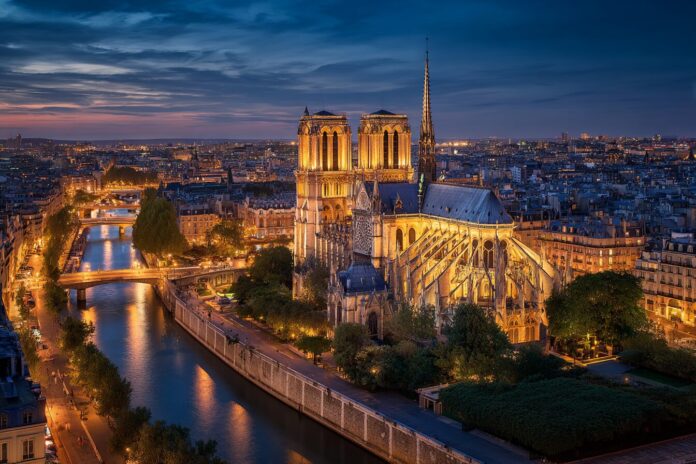A New Digital Era for an Iconic Monument
Few structures embody the spirit of Paris quite like Notre-Dame Cathedral. After the devastating fire in 2019, the global community watched with bated breath as experts labored to restore more than just stone and stained glass. Most importantly, the restoration reignited a passion for cultural preservation, prompting a new discussion on how historical monuments can be experienced in the digital realm.
Because modern technology offers innovative solutions, the digital resurrection of Notre-Dame is not merely an act of technical recreation—it is a profound tribute to human ingenuity and resilience. By capturing every detail of the cathedral’s architecture, this project aims to safeguard an irreplaceable piece of history for future generations.
Microsoft and France: A Powerful Partnership
In a groundbreaking collaboration, Microsoft has partnered with the French government and pioneering start-up Iconem to create a comprehensive digital twin of Notre-Dame. Besides that, this union blends cutting-edge imaging technologies with state-of-the-art artificial intelligence to capture the soul of this historic monument. According to Microsoft’s president, Brad Smith, the project is designed to “preserve permanently in digital form every detail of Notre-Dame, ensuring that its structure, story, and symbolism are protected and accessible for generations to come.”
Because of the collaboration’s ambition, leading experts and innovators are coming together to set a precedent for how technology can be harnessed for cultural heritage. For more detailed insights, you can read the full report on Euronews and detailed updates at Devdiscourse.
Technological Innovation Underlying the Digital Twin
Because innovative imaging techniques are at the core of this project, the digital twin of Notre-Dame is created through the integration of thousands of photographs, drone footage, and laser scans. These technologies together capture every intricate aspect of the cathedral, from its soaring arches to the delicate carvings adorning its stones. Most importantly, artificial intelligence comes into play to stitch these massive datasets into a coherent, interactive model.
Therefore, the digital twin stands as a remarkable achievement in precision and creativity. Experts are employing AI algorithms to ensure that every centimeter of the site is documented with extraordinary clarity. For further reading on how AI is being deployed, visit Observer and Artnet News for additional perspectives.
Why a Digital Twin Matters
There are numerous compelling reasons for this extraordinary undertaking. First and foremost, the digital twin serves as a permanent historical archive, enabling future conservationists to study and restore the site with unprecedented accuracy. Because every detail is meticulously recorded, restoration experts can refer back to original data when unforeseen challenges arise.
Moreover, the digital twin expands the visitor experience, allowing global audiences to virtually explore the grandeur of Notre-Dame. Virtual tours will enable people from all over the world to appreciate the cathedral’s beauty, even if they cannot travel to Paris. Additionally, maintenance and restoration efforts are benefited by the precise architectural blueprint, reducing risks and accelerating decision-making processes.
Beyond the Cathedral: Implications for Global Cultural Heritage
Besides the iconic Notre-Dame, Microsoft’s initiative symbolizes a broader movement towards digital preservation of cultural heritage. Similar projects, such as the digitalization efforts for other significant landmarks like St. Peter’s Basilica, inspire confidence in technology’s ability to preserve history. Because this project sets a pioneering example, it has the potential to catalyze further digital resurrection projects around the globe.
Furthermore, this innovative approach not only preserves aesthetics and architecture but also educates and inspires. For instance, through interactive digital tours, users can explore historical contexts and artistic details that traditional exhibits might overlook. For more in-depth discussion on these collaborations, please visit VOV World.
Future Perspectives and the Transformative Potential of Digital Twins
As immersive technologies continue to evolve, digital twins like the one for Notre-Dame are poised to become essential tools in heritage preservation. Most importantly, they democratize access to cultural landmarks, making them available to a global audience and allowing everyone to experience the historical and architectural marvels of our world. Because these digital models can be updated continuously, they offer resilience against future threats and tragedies.
Besides that, this trajectory represents a paradigm shift in how we document and respect our history. With further advancements, we may soon see more historic sites being digitally resurrected, alongside educational programs that leverage these models for interactive learning. The future of cultural heritage is undoubtedly digital, and Microsoft’s initiative today paves the way for tomorrow’s innovations.
References
For additional insights and comprehensive coverage of this innovative project, readers are encouraged to explore the following sources:
- Euronews: Microsoft to make Notre-Dame digital twin and boost its European languages for its AI models
- Devdiscourse: Microsoft and France Collaborate on Notre-Dame’s Digital Resurrection
- VOV World: Microsoft Partners with French Government to Create Notre-Dame’s Digital Replica
- Observer: The Second Life of Notre Dame: Microsoft Backs a Digital Resurrection
- Artnet News: Notre-Dame Is Getting an A.I.-Powered Digital Twin



